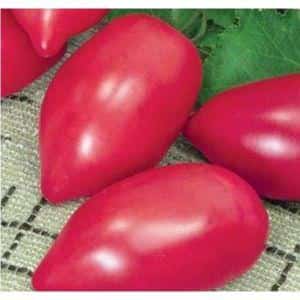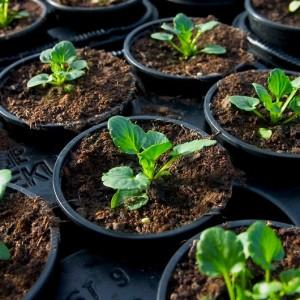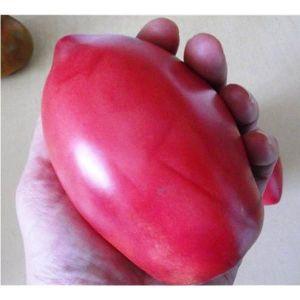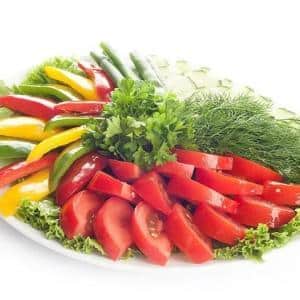Capricious to care for, but loved by summer residents, the “Pink Flamingo” tomato: characteristics and description of the variety
The Pink Flamingo tomato got its name for its pleasant pinkish tint. The variety is widespread in central Russia and the southern regions. It is recommended to plant Flamingos exclusively in greenhouses.
It is famous for its excellent taste and aroma, as well as high yield. We will consider the detailed characteristics and description of the variety below.
Description of the variety
The variety belongs to the mid-early variety. The ripening period of tomatoes varies from 90 to 95 days. Despite this, tomatoes take a long time to set, right up to autumn frosts. The bushes are well coordinated, strong, and can decorate any garden. Stems are powerful, foliage is medium.
Distinctive features
The bushes reach a height of 1.5 to 1.8 m. Due to their size, they require a mandatory garter to a support. The leaves are original, carved, and have a rich green tint. The pink flamingo is picky about soil, so the best place for it would be fertile and clean soil.
Characteristics of tomatoes, yield
Tomatoes have an elongated oval shape. The average weight of one is about 180 g, in some cases reaching 400 g. As a rule, the first ripened tomatoes are the largest, the subsequent ones grow a little smaller. The color is pink-raspberry, the skin is smooth and dense. There are few seeds, the pulp is juicy, not watery.
The yield of the variety is average. In a good year you can collect up to 10 kg from 1 sq.m. If the summer turned out to be unfavorable, then about 5-7 kg.Average yields are often compensated by high disease resistance.
How to grow seedlings
Many gardeners prefer to grow their own seedlings. The optimal time is 50-60 days before the intended planting in the ground.
If sowed too early, the seedlings stretch out and take root poorly. Before sowing, you should prepare everything you need. Consider below an overview of useful tips for growing seedlings.
Seed preparation
Seeds need pre-treatment. For example, you can soak them in a solution of Agricola Vegeta liquid fertilizer. The temperature of the solution should be at least 20 degrees, the soaking time should be 24 hours.
For convenience, it is recommended to place the seeds in a bag, and only then into the solution. Then you can put them in the same bag in the refrigerator for two days, after which you can immediately plant them as seedlings. This will make the plant immune to frost.
It would not be a bad idea to germinate the seeds. To do this, put them in a damp bag and leave them in this form until the first entrances. However, some gardeners are against germination - they claim that the soil best accepts dry seeds.
Container and soil
For seedlings, flower pots, plastic cups, and boxes are used. Often gardeners prefer to grow seedlings in peat pots. Firstly, the porous surface provides the necessary water-air regime inside it, which is why the seedlings develop faster. Secondly, peat pots are made from environmentally friendly material and are highly durable.
It is necessary to plant seedlings only in specially prepared soil. The ideal mixture should contain:
- humus - is a mixture of grass and manure;
- peat - is responsible for the level of moisture in the soil, and also contributes to the creation of good looseness;
- sand or sawdust - serve as natural leavening agents;
- leaf soil - saturates the seedlings with additional nutrients.
Preparing the soil for seedlings involves mixing the above components. To do this, you can spread polyethylene on the floor and pour on it in a 4:1 ratio of parts of humus to parts of the remaining components. To obtain the most effective result, it is recommended to add half a bucket of wood ash.
Important! The mixture must be disinfected. For example, pour boiling water or hydrogen peroxide on it. This will kill all germs and pathogens.
Sowing
On the day of sowing, slightly moist soil is poured into the cups, compacted a little and watered again with warm, settled water. It is recommended to add growth stimulator “Bud”. Then make a hole 1.5 cm deep in each cup, place a seed in it and sprinkle soil on top. It is best to sow early in the morning.
Growing and care
The containers are placed in a bright and warm place. The air temperature must be at least 25 degrees. After 5-6 days, you can put film or special caps on the containers. This is necessary for the fastest appearance of inputs. After this, the film is removed.
During the first 20 days, seedlings grow slowly. To prevent it from stretching, it is recommended to monitor the lighting and air temperature. It is best to water young seedlings at the root so that moisture does not get on the leaves and stem.
When the seedlings have one leaf each, organize the first feeding. To do this, you can use the growth stimulator "Kornerost". As the name suggests, the drug strengthens the root system and gives the plant additional development.
Water seedlings should be planted once a week. Do not allow the soil to dry out or become waterlogged. Also, never water the seedlings with cold tap water. All this can lead to vegetables cracking and losing their taste.
Important! It is necessary to harden the seedlings - on warm days, take them out to the balcony, or simply open the windows in the apartment. This should be done around the end of April-beginning of May. During the hardening period, carefully monitor watering - if there is a lack of moisture, the sprouts will wither.
How to grow tomatoes
The pink flamingo loves fertile soils and high-quality fertilizers. Therefore, before planting, it is necessary to study all biotechniques and care tips.
Landing
Seedlings are planted in the ground around the end of May-beginning of July. It is recommended to plant pink flamingos in a greenhouse, since in open ground the yield is significantly reduced. Tomatoes do not like acidic soil, so avoid areas where potatoes were previously planted.
It is also necessary to disinfect the soil and hard surfaces in the greenhouse in advance. To do this, dilute a solution of potassium permanganate and wipe the structure with it, and simply water the ground.
Care
First of all, the variety needs to be formed. To do this, pinch the side shoots and remove the lower leaves. Formation allows the plant to receive more air and light, and also improves the amount of future harvest, since the bush has more resources.
Also, the Pink Flamingo needs to be watered regularly with settled water. Sometimes, to prevent disease, you can add an infusion of garlic or dandelion to the water.Make sure that the main moisture falls under the root and not on the stem or leaves. In addition to watering, remove stepchildren in a timely manner - these are additional shoots that need to be carefully plucked off every 10-12 days.
Important! Important in caring for the Pink Flamingo are: feeding. At first, seaweed extract will be a good fertilizer for the variety. Next, gradually add nitrogen-containing fertilizers such as superphosphate and ammonium nitrate.
Features of cultivation and possible difficulties
Monitor the air temperature and humidity. Average daily temperatures should be from 16 to 28 degrees. At low temperatures, growth slows down, and at higher temperatures, the risk of cracking of tomatoes increases. Many gardeners use a drip irrigation system to care for their crops. This is an ideal solution for moistening the soil.
In addition, monitor the amount of fertilizer applied. Sometimes there is an excess of nitrogen-containing substances, as a result of which the bushes wither and die. To prevent this from happening, it is recommended to alternate mineral and organic fertilizers. Among organic fertilizers, ash and mullein perform well.
Diseases and pests
Pink flamingo is a variety with increased immunity to fungi, pests and diseases. However, preventive measures should not be neglected.
For example, as a preventive measure against microorganisms, it is recommended to spray the bushes with a whey solution. The product especially helps against tobacco mosaic. Weekly spraying with plain milk will protect the plant from late blight.
An effective remedy from insect pests solutions based on garlic or onion peels are recognized.These folk remedies will not only protect the crop from the Colorado potato beetle, wireworm and other pests, but will also save you money.
The nuances of growing in open ground and in a greenhouse
Both in the greenhouse and in the open ground, the Pink Flamingo must be tied up so that the stem does not bend or break under the weight of the tomatoes.
The vertical position of the bush provides maximum fresh air and sunlight. In addition, tied tomatoes are easier to spray, and the bushes are less susceptible to diseases.
Start off garter should be 3 weeks after planting the seedlings in the ground. Wooden or metal pegs and twine work best for anchoring. You need to tie the tomato loosely so that the twine does not cut into the stem of the plant. It is necessary to secure the twine to a peg, wrap it around the stem and tie it.
Important! Never work with wet plants. Let the bush dry thoroughly and only then proceed with the main activities.
In addition, it is recommended to plant pollinating plants next to the tomato beds. Monarda, basil or marigolds are used to attract insects. They not only attract bees or butterflies, but also improve the taste of vegetables, making them even juicier. This is especially true for greenhouse beds.
Do not forget to periodically ventilate greenhouses. It is recommended to do this using special windows or open doors. Some gardeners install fans in greenhouses. Excess moisture is unacceptable, otherwise the plants will develop late blight or root rot.
Harvesting and application
It is best to harvest Pink Flamingo when the tomatoes are already ripe and have acquired shine.But it is also not prohibited to collect vegetables a little earlier and place them in a dark, cool place until fully ripe. Store tomatoes in the refrigerator Not recommended. Cold spoils their taste and slows down ripening.
Vegetables are used in the preparation of pizzas, salads, sandwiches, salsa, soups, juices and many other dishes. Pink flamingo has a sweetish taste, so it will harmoniously complement almost any food.
Tomatoes are even used in the preparation of cosmetic care products. For example, a mask made from tomato juice and glycerin is widely popular. It moisturizes the skin and has a healing effect against acne.
Tomato is also used in folk medicine. Even simple fresh consumption has a beneficial effect on human health.
The vegetable is capable of:
- regulate metabolic processes;
- strengthen the functioning of the kidneys and gonads;
- improve mood and cope with stress;
- regulate the activity of the gastrointestinal tract.
Advantages and disadvantages of the variety
In addition to its excellent taste, the Pink Flamingo tomato is valued for:
- excellent immunity to diseases and pests;
- good keeping quality;
- ability to ripen outside the garden bed.
Among the disadvantages, gardeners note:
- average yield;
- demands on soil and fertilizing;
- the formation of bushes is mandatory.
Farmer reviews
Before planting this or that variety of tomatoes, it is worth studying the reviews of gardeners who have already assessed the taste and other qualities of the fruit. Let's look at some of them about Pink Flamingo tomatoes.

Marina, Troitsk: “The variety exceeded all my expectations. Reviews from neighbors in the garden were either very bad or very good. I had my doubts, but the harvest amazed me.I have never been able to grow such large tomatoes. I will be planting even more Pink Flamingos next year.”
Pavel Yeisk: “I decided to take a risk and planted the Flamingo outside the greenhouse. Surprisingly, the variety sprouted well. Of course, he is demanding of himself, and he has to spend a lot of time caring for him. But the tomatoes taste great, I especially love sun-dried tomatoes.”
Nikolay, Moscow region: “I grow about 15 varieties of different tomatoes in my garden. I didn't like the pink flamingo at all. The yield turned out to be so-so, and the taste of the vegetables is not bright, there is a lot of water in the pulp. I won’t plant Flamingos again, that’s for sure.”
Conclusion
Pink flamingo is an interesting representative of mid-early varieties. Reviews about it on the Internet are contradictory: some praise the variety for its taste and productivity, others claim that the end does not justify the means, and the tomato is too demanding. Be that as it may, everyone should try to raise a Flamingo.